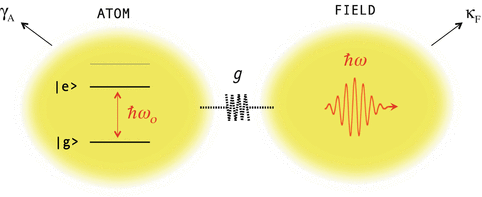1.1 Introduction
One of the main thrusts of contemporary physics is quantum engineering, aiming to exploit the properties of quantum systems for information storage, processing and transmission. The fundamental building block of any quantum device is the quantum mechanical two-level system (TLS). In practice, atoms, ions, molecules and solid-state defect centers have been identified as near ideal representations of such a TLS. With the energy-level splittings in these systems corresponding to optical frequencies, light fields provide a handle to control the internal dynamics of such a TLS. To achieve maximum fidelity of the operations on the quantum system, the interaction strength between the electromagnetic field and the TLS has to be maximized by maximizing the field strength at the position of the TLS. Nanophotonics has developed a powerful toolbox to control light at the subwavelength scale, allowing the confinement of electromagnetic radiation to volumes smaller than the limit imposed by diffraction. With the quality factors of nanophotonic resonators increasing, accompanied by shrinking mode volumes, the interaction strength between a single quantum emitter and a nanophotonic resonator is reaching a level where coherent quantum mechanical effects are observable. Various coherent control schemes, such as Rabi oscillations []. However, a classical Newtonian model describing the internal dynamics of a quantum system driven by an external field has been missing to date.
Here, we present a classical model for the interaction of a quantum mechanical TLS with a classical optical field. We construct a mechanical atom , consisting of a pair of coupled classical harmonic oscillators. The coupling gives rise to two eigenmodes, split in frequency according to the strength of the coupling between the bare oscillators. These eigenmodes play the role the two states of a quantum mechanical TLS. The interaction between the mechanical atom and a driving field is reflected in the modulation of the spring constants of the bare oscillators. Under this parametric driving, the Newtonian equations of motion describing the evolution of our mechanical atom take the exact same form as the optical Bloch equations derived from a semiclassical model based on the Schrdinger equation. Accordingly, our model provides as intuitive classical approach to understanding the coherent dynamics of a quantum mechanical TLS.
1.2 Semiclassical Treatment
Figure conceptually illustrates the interaction between light and matter in a semiclassical framework. The matter part is described by a TLS, from now on termed atom for simplicity, with an electronic ground state| g and an excited state| e . The two atomic states are separated by the energy 0, with 0 the transition frequency. The spontaneous decay rate of the atom is A . The interaction of the two systems is characterized by the coupling rate g , which derives from the interaction Hamiltonian as g = H int. In the dipole approximation the interaction Hamiltonian can be written as H int= p E , with p denoting the transition dipole between| g and| e . Furthermore, E ( t )= E 0cos t is a classical time-harmonic electric field. Under the influence of the optical field, the wave function of the atom can be written as a superposition of its ground and excited state
Fig. 1.1
Schematic of light-matter interactions. The optical field is characterized by the frequency and the atom (matter) is represented by two electronic states| g and| e separated by the energy 0. The interaction of the two systems is characterized by the coupling rate g . The excited-state spontaneous decay rate of the atom is A
where a ( t ) and b ( t ) are complex time dependent coefficients. They are found by inserting Eq.( ]) and we only outline the main aspects here. It is convenient to offset the energy scale, such that the energies of ground state and excited state are E g = 02 and E e =+ 02, respectively, and then move to the rotating frame, that is, performing the transformation
Inserting Eqs.() into the Schrdinger equation and performing the rotating wave approximation (i.e. assuming 0), we obtain
where we have defined the detuning between the driving frequency and the transition frequency
and the coupling rate
which is also denoted as the classical Rabi frequency. Note that the spontaneous decay rate of the atom does not appear in the semiclassical framework and has to be inserted by hand into the equations of motion in ( ]. For our purposes, we neglect spontaneous decay, which places our discussion into the regime of strong driving, where R > A holds for any finite driving field.
Using arbitrary initial conditions

and

, the solutions of Eq.( ]

















 and
and  , the solutions of Eq.( ]
, the solutions of Eq.( ] 